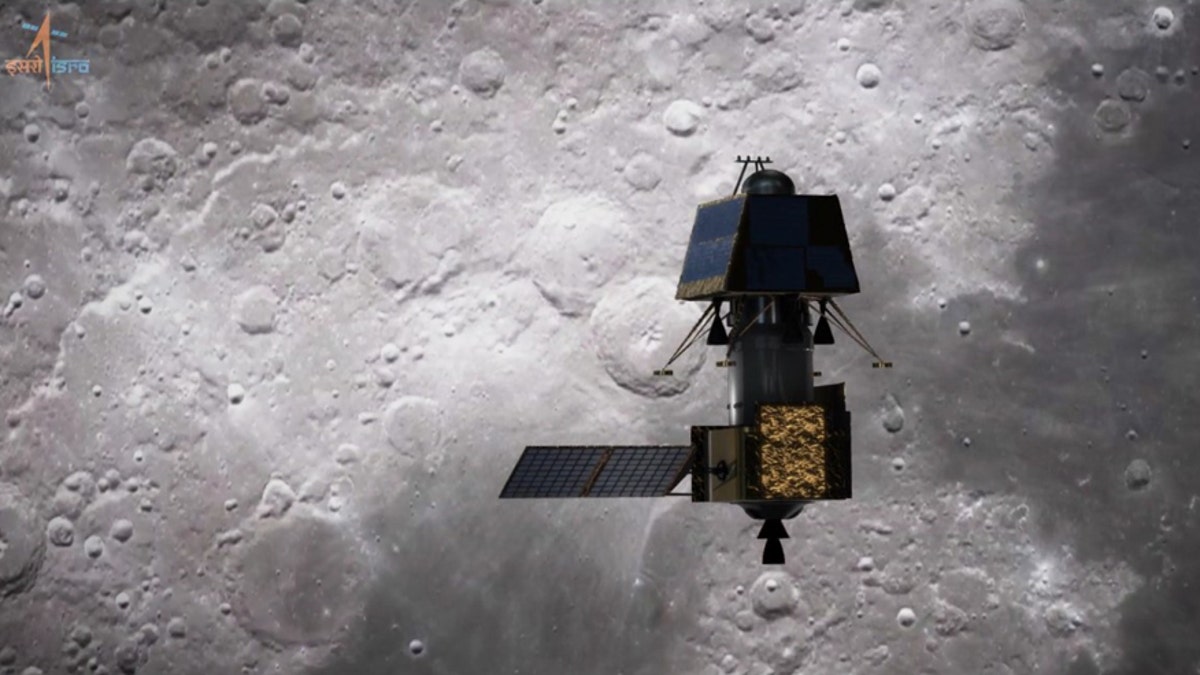50 years after Apollo 11, Neil Armstrong’s sons describe watching their dad walk on the Moon
50 years after the Apollo 11 mission, Neil Armstrong’s sons Mark and Rick describe the day when their father walked on the Moon.
India’s historic Vikram lander made a “hard landing” on the lunar surface earlier this month, according to NASA.
The Indian Space Research Organization lost contact with the unmanned probe when it was in the final stage of an audacious Moon landing attempt on Sept. 6. Communication with the lander was lost when it was just 1.3 miles from the lunar surface.
On Sept. 10, ISRO tweeted that Vikram was spotted on the lunar surface by the space agency's Chandrayaan-2 orbiter. Vikram's fate remains shrouded in uncertainty, as NASA's Lunar Reconnaissance Orbiter has yet to spot any evidence of the probe.
INDIA LOSES CONTACT WITH VIKRAM PROBE IN MOON LANDING ATTEMPT
“Vikram had a hard landing and the precise location of the spacecraft in the lunar highlands has yet to be determined,” said NASA in a statement posted Thursday.

A wide view of a series of Lunar Reconnaissance Orbiter Camera's narrow-angle camera images collected on Sept. 17 showing the area of the targeted Vikram landing site.
The extent of the damage suffered by Vikram is not clear.
“The Lunar Reconnaissance Orbiter (LRO) passed over the landing site on Sept. 17 and acquired a set of high resolution images of the area; so far the LROC team has not been able to locate or image the lander,” said NASA in its statement. “It was dusk when the landing area was imaged and thus large shadows covered much of the terrain; it is possible that the Vikram lander is hiding in a shadow. The lighting will be favorable when LRO passes over the site in October and once again attempts to locate and image the lander.”
INDIA FINDS MISSING VIKRAM PROBE ON THE SURFACE OF THE MOON
Vikram and its rover had a lifespan of one lunar day, which is equal to 14 Earth days, according to ISRO. This means that the probe reached the end of its life on Sept. 20. ISRO’s Chandrayaan-2 orbiter will continue its mission for a year.

A view looking down on the Vikram landing site (image acquired before the landing attempt), image width 54 miles. (NASA/Goddard/Arizona State University)
The U.S., Russia and China are the only countries to have successfully made “soft landings” on the Moon. Earlier this year, Israel's uncrewed Beresheet spacecraft crashed during a Moon landing attempt.
VIKRAM MOON LANDER: THE ANXIOUS WAIT FOR A SIGNAL FROM LUNAR SURFACE
The Chandrayaan-2 spacecraft carrying the Vikram Lander launched from Sriharikota in southern India on July 22.

Artist's impression of Chandrayaan-2 from ISRO video. (ISRO)
India's first lunar mission, Chandrayaan-1, orbited the Moon in 2008 but did not land there. It did, however, launch an impact probe that was intentionally crashed into the Moon.
Chandrayaan-1 operated for 312 days.
VIKRAM MOON LANDER: TIME IS RUNNING OUT FOR SCIENTISTS TO MAKE CONTACT WITH PROBE
The Moon looms large for a number of countries’ space programs. China, for example, became the first country to successfully land a probe on the far side earlier this year when the Chang’e 4 lander reached the lunar surface on Jan. 2.
The U.S. also has its sights set on the celestial satellite and plans to land American astronauts, including the first woman, by 2024. The Artemis program will also establish a sustainable human presence.
APOLLO 11: HOW 'DUMB LUCK' SAVED ICONIC MOON PHOTOS FROM BEING DESTROYED
NASA recently revealed details of its vision for the Artemis Moon Lander.
Speaking at Kennedy Space Center on the 50th anniversary of the Apollo 11 moon landing on July 20, Vice President Pence announced that the Orion capsule that will take American astronauts back to the satellite is ready.
Since Apollo 11 astronauts Neil Armstrong and Buzz Aldrin set foot on the surface, only 10 more men, all Americans, have walked there.
CLICK HERE TO GET THE FOX NEWS APP
At a White House event in July, Aldrin voiced his disappointment over America’s space progress since the days of Apollo 11.
Fox News’ Chris Ciaccia, Morgan Cheung and The Associated Press contributed to this article. Follow James Rogers on Twitter @jamesjrogers

